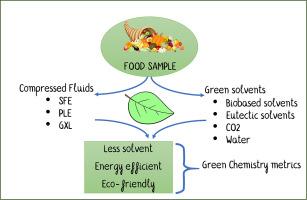Innovative sample preparation techniques in food analysis: the rise of compressed fluids and novel solvents
IF 6.5
Q1 CHEMISTRY, ANALYTICAL
引用次数: 0
Abstract
Compressed fluids and novel green solvents represent the most promising approaches for achieving sustainable sample preparation in food analysis. Traditional extraction techniques often rely on toxic organic solvents and energy-intensive processes, leading to environmental concerns and inefficient workflows. Green Analytical Chemistry (GAC) promotes the adoption of eco-friendly alternatives that minimize solvent consumption, reduce waste, and enhance extraction efficiency. This review explores the role of compressed fluids’ technologies, including Pressurized Liquid Extraction (PLE), Supercritical Fluid Extraction (SFE), and Gas-Expanded Liquid Extraction (GXL) as viable replacements for conventional solvent-based methods. These techniques offer high selectivity, shorter extraction times, and lower environmental impact. Additionally, novel solvents such as deep eutectic solvents (DES), bio-based alternatives, and gas-expanded liquids present sustainable solutions that improve biodegradability, safety, and solvent recyclability. By integrating these innovative approaches into analytical workflows, food analysis can align with Green Chemistry principles while maintaining high analytical performance. This review critically evaluates the latest advancements in green sample preparation techniques based on pressurized fluids, highlighting their transformative potential in food safety, authenticity verification, and bioactive compound extraction.

食品分析中的创新样品制备技术:压缩流体和新型溶剂的兴起
压缩流体和新型绿色溶剂代表了在食品分析中实现可持续样品制备的最有前途的方法。传统的提取技术通常依赖于有毒的有机溶剂和能源密集型工艺,导致环境问题和低效的工作流程。绿色分析化学(GAC)提倡采用环保的替代品,最大限度地减少溶剂消耗,减少浪费,提高提取效率。本文综述了压缩流体技术的作用,包括加压液体萃取(PLE)、超临界流体萃取(SFE)和气体膨胀液体萃取(GXL)作为传统溶剂基方法的可行替代品。这些技术具有高选择性、较短的提取时间和较低的环境影响。此外,新型溶剂,如深共晶溶剂(DES)、生物基替代品和气体膨胀液体,提供了可持续的解决方案,提高了生物降解性、安全性和溶剂可回收性。通过将这些创新的方法集成到分析工作流程中,食品分析可以与绿色化学原则保持一致,同时保持高分析性能。这篇综述批判性地评估了基于加压流体的绿色样品制备技术的最新进展,强调了它们在食品安全、真实性验证和生物活性化合物提取方面的变革潜力。
本文章由计算机程序翻译,如有差异,请以英文原文为准。
求助全文
约1分钟内获得全文
求助全文

 求助内容:
求助内容: 应助结果提醒方式:
应助结果提醒方式:


